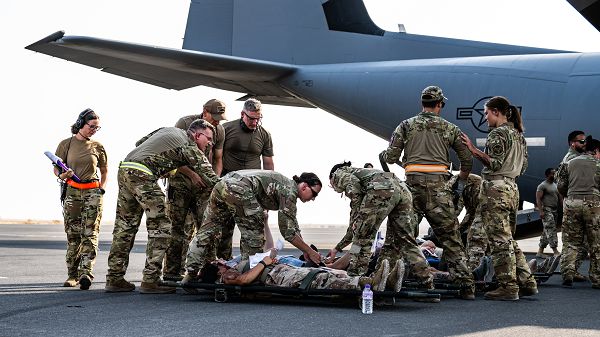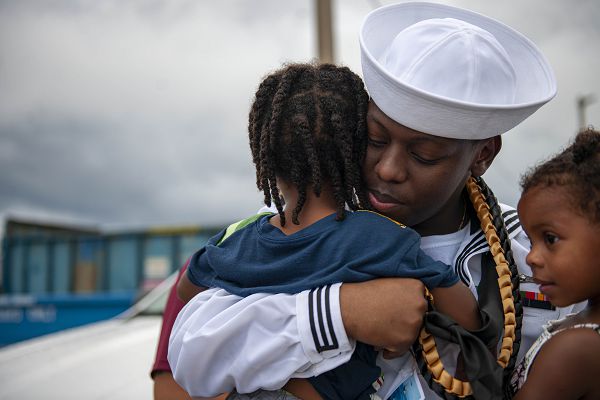- Details
- Hits: 341

Salem Air Base, Kuwait. (August 19, 2023): American troops are told that, if they are injured in combat, they will receive lifesaving care during the “golden hour”, the time it takes to get a warfighter to a proper hospital. In this photo by Staff Sergeant Kevin Long, U.S. Air Force Medical personnel from the 386th Expeditionary Medical Squadron field response team and the 405th Expeditionary Aeromedical Evacuation Squadron prepare to load victims from a simulated attack onto a C-130J Super Hercules. This training to handle a mass-casualty event gave multiple wings and squadrons the chance to put their life-saving medical capabilities to the test.
Medical evacuation teams like these are adapting to the new reality of war against a “near peer” rival like China. In the wars in Iraq and Afghanistan, aeromedical evacuation squadrons were able to provide immediate care and swift evacuations due to American air superiority. These squadrons had the time to get a wounded warfighter off the battlefield and into a proper hospital within one hour of their being injured. Treating these patients quickly greatly improves outcomes.
This “golden hour” standard, however, may not be possible in future wars.
The near total air superiority enjoyed by U.S. units may not be the case against an adversary like China or Russia. Worse, future conflicts are likely to be large-scale operations dispersed around the world thus complicating the task of evacuating casualties quickly.
Based on these realities, American planners realize that the "golden hour" handoff to surgical teams will not be possible. This puts extreme pressure on Special Operations medics and duty corpsmen to master advanced care methods including administering pain medications, long-term pain control, airway management, and nursing skills like changing dressings. Instead of quick evacuations, injured warfighters will need to be treated near the front lines, sometimes for days.
- Details
- Hits: 409

Lahaina, Maui. (August 21, 2023): The servicemembers of the Hawaii National Guard, many of whom are themselves victims of the recent wildfires, have sprung into action to help their neighbors. In this photo by Sergeant Andrew Jackson, search and rescue Soldiers and Airmen assist with recovery efforts as part of the national Lahaina wildfire response. Guardsmen mobilized after the fire to sweep the affected area for dangers before it can be reopened to the public.
Hawaii is unique in having both an Army and Air Force component in their National Guard which has proven especially critical in these types of emergencies. Hawaii’s 154th Air Wing, based at Hickam Field, Honolulu, has extensive airlift capability including refueling squadrons and helicopter fleet. The Army component consists of the 29th Infantry Brigade Combat Team, the 103rd Troop Command, and the 298th Regiment Training Institute. Its medical detachment has the highest readiness percentage than any other unit in the Army National Guard. Together, these units conduct multiple exercises each year to be ready for any emergency. The Guard participates in an annual tsunami response exercise along with active-duty troops from across the Pacific.
Despite this training, nothing could prepare these troops for the grim task that lies ahead. Troops will continue to search for hundreds of missing people in the historic coastal port city of Lahaina. As of this writing, the death toll has risen to at least 114, but unfortunately many more are expected.
Officials estimate at least 2,200 structures have been destroyed and another 500 damaged in the blaze at an estimated cost of about $6 billion.
- Details
- Hits: 365

Okinawa, Japan. (August 20, 2023): In this photo by Corporal Alora J. Finigan, Marine Corporal Matthew Kamm, left, a transmission systems operator, and Lance Corporal Ali Fish, right a data systems administrator, both with Communications Company, Headquarters Battalion, 3rd Marine Division, load debris into a seven-ton truck at Camp Courtney, Okinawa after Typhoon Khanun. The typhoon struck the island in early August with category 4 hurricane high winds, heavy rain, and high seas in one of the strongest storms to hit Japan in years.
Immediately after the storm, Marines moved out across the island to assess damage and begin repairs to ensure the III Marine Expeditionary Force remains operational. Typhoon Khanun went on to pummel the west coast of the Korean Peninsula causing widespread flooding and at least two deaths.
Camp Courtney is named after Major Henry A. Courtney who was killed in action on Okinawa and was awarded the Congressional Medal of Honor. Courtney hailed from Duluth, Minnesota and received his law degree from Loyola University before the outbreak of war.
Major Courtney fought at the battles of Guadalcanal and the Solomon Islands before participating in the invasion of Okinawa and what would become known as the battle for Sugar Loaf hill. This group of three small knolls were honeycombed with well dug in enemy forces and each could defend the other with interlocking fields of fire. While these unassuming little hills did not appear to be anything more than a bump in the road to the Marines, they would soon find themselves fighting for their lives.
While serving as executive officer of a battalion of the 22nd Marines, 6th Marine Division, Major Courtney led a successful night attack against Sugar Loaf hill when he was killed in action after exhibiting great courage and self-sacrifice. He is a posthumous recipient of the Medal of Honor and the Purple Heart.
- Details
- Hits: 459

Colorado Springs, Colorado. (August 12, 2023): Bursting with youthful exuberance, Air force Basic Cadet Trainees endure a rite of passage during Basic Cadet Training. In this photo by Rayna Grace, Basic Cadets from the Class of 2027 complete the obstacle course at the U.S. Air Force Academy's Jacks Valley training area in Colorado Springs, Colorado. Basic Cadet Training is a six-week indoctrination program to guide the transformation of new cadets from being civilians to military academy cadets prepared to enter a four-year officer commissioning program.
The Class of 2027 has 130 cadets who are 70 percent men and thirty percent women with one third racial minorities. They are a smart bunch with 53 percent finishing in the top ten in their high school graduating class.
These young cadets endure a two-phase program that pushes them to their mental and physical limits. The first phase of Basic, called life "On the Hill" , is especially difficult for these newcomers as they make the transition from civilian to military life. Physical exercise begins at dawn and continues throughout each day, before and after breakfast, lunch, and dinner.
- Details
- Hits: 323

Washington, D.C. (Aug. 8, 2023): In this photo by Master Chief Musician Adam Grimm, Musician 1st Class Michaela Swan, from Rochester, New York, performs with the U.S. Navy Band at the U.S. Navy Memorial in Washington. The Navy Band performed at the Navy Memorial as part of its annual Concert on the Avenue series, telling the Navy story through a mix of popular songs and patriotic music.
One of our nation’s oldest traditions, the United States Navy Band is based at the Washington Navy Yard and has served as the official musical organization of the U.S. Navy since 1925. The band serves the ceremonial needs at the seat of U.S. government, performing at presidential inaugurations, state arrival ceremonies, state funerals, state dinners, and other significant events. The band performs a broad range of music, including ceremonial ruffles and flourishes, classical, rock, jazz, and country.
The earliest music aboard United States Navy ships was the Shantyman’s songs, melodies of the sea that helped soften the hard edge of shipboard life. From these humble songs followed trumpeters, drummers, and fifers who were carried on the early frigates to sound calls, give general orders, and perform at funerals and other ceremonies. Military bands became a separate section of the crew on many Navy vessels.
President Calvin Coolidge signed into law a 1925 bill stating "hereafter the band now stationed at the Navy Yard, known as the Navy Yard Band, shall be designated as the United States Navy Band." The legislation also allowed the band to take its first national tour in 1925.
- Details
- Hits: 373

Naval Base Guam. (Aug. 5, 2023): Few Americans will experience the confined life of a Sailor aboard America’s submarines while serving months at sea. In this photo by MC1 Justin Wolpert, a Sailor assigned to the Los Angeles-class fast-attack submarine USS Annapolis hugs his children during the boat's homecoming celebration after a six-month deployment. Life aboard these undersea warships is one of the toughest and most rewarding jobs in the Navy. Life for these Sailors is quite different, however, than most civilians can imagine.
Theirs is a dark, cramped, windowless world of round the clock shift work on an 18-hour daily schedule. Life aboard is divided into three six-hour periods, sleeping, working, or spending free time. Due to the lack of light on a sub, mariners lose track of time to the point where they only realize it is morning because they are eating breakfast. Because a third of a submarine houses the nuclear reactor, there is not enough room for Sailors to have their own “rack” so they share bunks and sleep in shifts. Space is so precious there are even bunks in the torpedo room.
Free time is spent in the mess halls watching television or working out in the ship’s tiny gym, usually just a few machines, to stay in shape. Submariners have limited contact with home while at sea, limited to emails that are exchanged when their sub surfaces but that is not very often.


